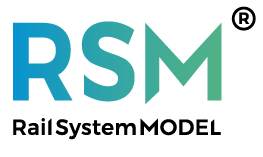Current RSM versions and extensions
All contents (versions, extensions, …) is under EUPL 1.2 License.
RSM 1.2 was released by UIC in 2021. EULYNX DataPrep currently uses this version.
RSM 1.2 (as published)
RSM 1.2 encompasses a “Common” package establishing fundamental engineering notions, based on various industry standards:
- Quantities according to SysML 1.2,
- Geodetic reference systems according to OGC,
- Linear referencing according to ISO 19148,
- Observations and Measures according to W3C SOSA/SSL ontologies, etc.
Another fundament is the railway network description:
- Topology: net elements (embodied by track or line sections) and their relations (navigable or non-navigable connections), with various levels of details;
- Networks, composed of their abstract topology and the concrete entities that realise the topology (tracks, switches, signals, …).
The “Infrastructure” package provides some of the most important Net Entities from various subsystems (Track, Energy, Signalling). Details are left to other, federated models such as EULYNX DataPrep for signalling.
RSM 1.2 was further developed in the context of the OPTIMA project. Purpose was to set up a Traffic Management System including fleet and passenger management.
RSM 1.2 + Rolling Stock and Operations
This extension is based on RSM 1.2, adding a Rolling Stock and an Operations package.
The Rolling Stock packages disentangle three views on Rolling Stock:
- the operator point of view: a set of vehicles “as planned”, providing services matching commercial requirements;
- the manufacturer point of view: a set of vehicles “as proposed” in their catalogue, composed of vehicle types that fulfill the commercial requirements;
- the asset manager point of view: a set of actual vehicles, with a chassis number (such as published in the European Vehicle Register), delivered conforming catalogue entries.
The three views are obviously linked, but comprise distinct objects, material or immaterial, and having different lifetimes.
The Operations packages deals with timetables, paths, trains (as a service run on the infrastructure). The concepts and terminology are closely derived from European legislation, in particular the TAF TSI, and the Joint Sector Handbook that details its concepts and usage.
